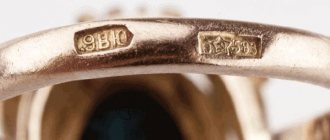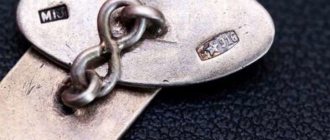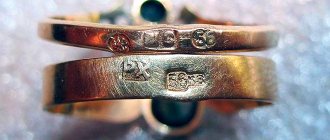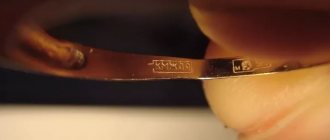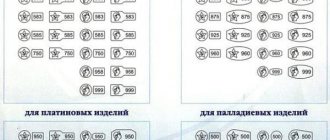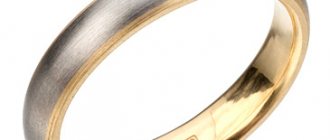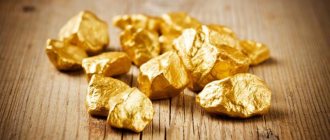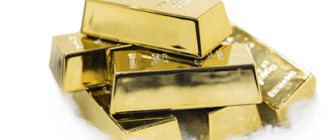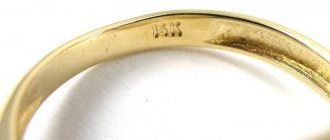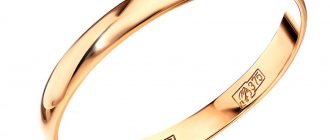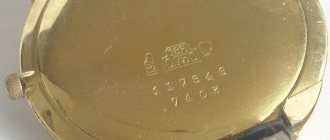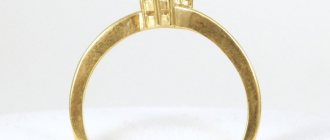Good day to all visitors to this page!
From the article you will learn what jewelry with the hallmark 875 is. They can be made of white or yellow metal with a shine. A large number of such things were produced in the USSR and were inherited from our mothers and grandmothers. It is difficult for an inexperienced person to determine from what material jewelry or cutlery is cast.
Some believe that there is 875 gold. Is it really?
What kind of metal is this - gold or silver?
In the Russian metric system, 875 gold does not exist. But there is silver of such a modification that explains the origin of objects on which the number “875” is written.
It is a noble metal with a main component content of 87.5%. The top of the item may be covered with gold, and unscrupulous sellers sometimes try to pass off the jewelry as gold.
Composition and properties
So, products labeled “875” are actually an alloy of the main element (Argentum) with other components. There is no jewelry made from 100% precious metal; a ligature is always added to it to improve its properties, primarily strength. The alloy may include:
- copper is the main element of the alloy;
- nickel;
- platinum.
Modern jewelry is often coated with a layer of rhodium on top to protect it from scratches and enhance shine.
Strength
The strength of 875 is better than that of an alloy with a higher content of the main element. This element itself is soft. An increase in hardness and strength is achieved due to the content of other components in the alloy, most often copper.
Peculiarities
It is known for certain that 925 silver alloy contains at least 7.5% Cu metal and 92.5% Ag metal, i.e. copper and silver. Copper gives strength to silver, allowing it to smelt high quality products. Today, 925 standard means that you are looking at silver, the quality of which is the highest of all possible. The metal, the purity of which is s925, has the following features:
- this silver alloy is easily processed into jewelry;
- metal is ductile, thanks to which any elements of an increased level of complexity can be made from it;
- The silver alloy can be top coated with a thin layer of gold plating.
When making a 925 sterling alloy, copper is added to pure silver, but as a result, the appearance of the products loses its shine over time and can darken when in contact with water. To improve the properties of the jewelry alloy, zinc, platinum, and germanium or silicon are added. Such additives make it possible to improve the color range of finished products and their characteristics. In the world of jewelers, 925 silver material can be designated as follows:
- sterling or sterling silver;
- standard silver or silver standard.
In addition to 925 standard, there is also 999 standard, which has more excellent qualities and high value among jewelers. However, you are unlikely to find products made from such metal on the open market, because expensive masterpieces are made from 999 silver.
What does the mark mean?
The main sign applied to modern silver items is a “barrel” with a number inside, which indicates the purity. Soviet-made items may be marked with a star, and even more ancient ones may have other markings.
To distinguish gold objects from silver, instead of a barrel, they place a brand with the silhouette of a woman in a kokoshnik. Sometimes you can see the marking AU (aurum).
The quality of jewelry is controlled and marked by the Assay Chamber of the Russian Federation. Designations of products manufactured and tested in another country may differ from Russian ones.
How to independently evaluate a product made of 875 silver?
It is possible to evaluate 875 silver by its mark; if the image is modern, then the cost of the product will vary from 20 to 40 rubles. per gram (at the Central Bank rate).
If a mark with the image of a five-pointed star or the head of a worker with a hammer is found on the product, then it is difficult to determine the price of such a product on your own. Examine the mark; the boundaries should be clear. Perhaps this is a rarity that will be purchased at tens or even hundreds of times the cost of a regular alloy.
How many carats are in this sample?
The carat system is used to determine the amount of pure substance in an alloy along with the metric system. Basically, the karat system is traditionally used in Western countries. 1 carat is 0.2 g.
The mark reflects the content of the main element in the alloy, with 24 carats being taken as 100%.
Below is a table of correspondence between markings in the metric and carat systems.
| Metric system | Carat system |
| 999 | 24 |
| 960 | 23 |
| 925 | 22 |
| 875 | 21 |
| 830 | 20 |
| 800 | 19 |
A foreign-made item marked “21 carats” will precisely correspond to the alloy of the Russian standard 875.
Reviews
My grandmother gave me a ring with a red stone that looked like a ruby. The test on it is interesting - 873, I didn’t see any stars nearby. Worn for evaluation, jewelers did not determine the type of stone. Some special analysis is needed. A very mysterious ring, but beautiful. It is clear that the metal is silver.
Anastasia R., Lviv
Maria P. g, Leningrad
We have a whole collection left over from my grandmother at home. Her grandfather often gave her silver jewelry. They were highly valued. Even today I wear some, and the rings look solid. We sold one of the jewelry, so the price was the same as for a new one, but simpler in composition. I'm pleasantly surprised. I will save the rest of the things for my children. Although they say that it is better to invest money not in jewelry, but in investment coins and bars, jewelry 875 with a star will also be appreciated, for sure.
Once I saw a very beautiful thing - a silver glass holder with a star. I just collect unusual things from that time. I bought it right away without even checking to see if it was precious. This thing was expensive, but it looked great. It was not even a pity to invest money.
Nikolay P. g, Moscow
Differences from 925 standard
Compared to 925, 875 contains less precious metal and more ligatures. Its features are greater hardness and less flexibility.
925 standard products are used mainly for the production of jewelry. It is less susceptible to oxidation, softer and more flexible.
875 variety is suitable for making dishes and cutlery. Due to the lower content of the main element, the price of the items becomes lower.
Marking
In pre-revolutionary Russia, the mark on silver items was made of two numbers, but after the revolution it already looks like a three-digit number.
- After the revolution, 875 standard was designated, in addition to numbers, by a letter and a sign of state testing supervision, which looked like a woman’s kokoshnik. During the Soviet era, products were marked with a sample number and a star imprint. Now such products are in high demand - they are bought by collectors.
- 925 standard marking was often accompanied by the inscription sterling silver, since this metal was called sterling silver after the name of the English silver coin of the same name, which could be used to purchase luxury items made of 925 standard silver. When marking high-quality 925 silver, you can also find such additions as ster, sterling. 925 silver, in addition to this inscription and a three-digit number, can also be marked with any image accepted in the country where the product was made.
- On gold-plated silver items, you can see the 5925 hallmark, which means that the item uses 925 silver and 5 microns of gold on top.
In jewelry stores, silver can be marked with hallmarks with officially recognized standards throughout the world - 999, 960, 925, 875, 830, 800. Other three-digit codes, for example, 923, 926, 929, 952 are not generally recognized.
Application area
875 is one of the most popular modifications of silver. This is mainly the so-called “silverware” - cup holders, spoons and other cutlery, as well as interior items (candlesticks, vases).
Less commonly, jewelry is made from material marked “875”. In the USSR, souvenirs were made from this material:
- ashtrays;
- cigarette cases;
- candy bowls;
- glasses.
How much does 1 gram of this sample cost in Russia?
Precious metals can be used to preserve and increase capital due to their ever-increasing price. But it is recommended to purchase bullion or special investment coins for these purposes, rather than jewelry: the price of the latter drops immediately after purchase, and with constant wearing and deterioration of appearance, it decreases even more.
In addition, the price of jewelry includes the work of a jeweler, service in a store, and the item itself does not consist of the main element 100% - it contains ligature, stones, etc. In the future, it can be sold or pawned in a pawnshop only at the price of scrap, which is not high.
| Price 999 standard according to the Central Bank | Market value of the sample today | Scrap price | Price in jewelry |
How can you recognize a fake?
There are several ways to determine whether it is silver or not:
- “lunar” metal has high thermal conductivity. If you hold it in your hand for a few minutes or put it in hot water for 10 seconds, it will quickly heat up to the temperature of your hand or water;
- Ag is not attracted to a magnet. If an object is magnetized, then it is not silver;
- sound and reflection of light. Silver is a very sonorous metal. If you drop a piece of jewelry from a meter high onto a hard floor, a loud vibrating sound will be heard. Silver also has a reflectivity of 96%, so it shines very brightly in the sun;
- if a low-quality product is sold, it will leave dark marks on the skin. To check, you need to rub it on the skin for about a minute and see the result;
- chalk can also be used for checking. Rub the silver with it. If dark stripes appear on the chalk, it means the metal is genuine;
- iodine testing. Drop iodine onto the item being tested. If it turns black, then it is silver. The disadvantage of such a test is that it is very difficult to remove the darkening later. If the stain turns out to be light, then it is not silver;
- Make a deeper scratch on the metal in an inconspicuous place. If there is material of a different color under the outer layer, it means the item was silvered. Drip vinegar into the groove formed. The appearance of green foam indicates a fake;
- Jewelry stores sell a kit with chemical reagents for testing silver. You can purchase a touchstone with it so as not to damage the object being tested. Then rub the test item on the stone. Drop the reagent from the kit onto the remaining trace. The quality of the product is determined by the resulting color. The color scheme is given in the table.
| Trace color | Sample metal |
| Scarlet, bright red | Silver 960 and above |
| Burgundy, dark red | Above 900 |
| Brown | Above 800 |
| Green | 700 and below |
| Blue | Nickel |
| Yellow | Lead, tin |
| Dark brown | Brass |
The Internet describes how to check with a lapis pencil. But I will question the relevance of this method, since finding a pencil now is problematic. Testing at home does not guarantee 100% accuracy. It is better to conduct it in a jewelry workshop or assay office.
Why do they fake it?
Sometimes sellers try to pass off products with the mark “875” as gold, because its price is several times higher than the cost of its counterpart. Gilded items, if you do not look at the markings, are very easy to confuse with gold. They try to pass off ordinary silver as white gold, although it differs in a number of external characteristics.
How to distinguish a fake from a genuine product
Even in the store, you must definitely pay attention to the brand applied to the item. To see it better, use a magnifying glass. If there is no mark, it is not a noble metal at all. A large number of scratches may indicate this.
In addition, the seller must have a certificate for the product. Silver is easily recognized by its softness - thin parts can be slightly deformed when pressed. Both in life and in the photo, gold has a more intense shine, while silver has a softer, muted shine.
Overview of species
When making a combined composition of the material, jewelers noticed that the way the metal looks depends on its ingredients. Through experimentation, not only various types of alloys emerged, but also methods for their decorative processing. The most popular types of silver are:
Blackened
The method of blackening appeared back in the days of Ancient Russia , when silver products were decorated with patterns of rich black color. If you combine sulfur, lead, copper and pure silver in certain proportions, you get a substance that in the old days was called “niello.” The finished product was subjected to artistic engraving, after which it needed to be heated until the blackening composition dissolved. The result of this work was a product that combines light silver and rich dark shades.
This method was used to decorate silver jewelry, household items, dishes, engravings, and so on. The demand for blackened silver was especially great in the 17th century. Products made from blackened silver alloy were particularly durable and did not require constant cleaning.
Oxidized
Another type of blackening, which was achieved by combining the metal Ag and the mineral S. Differing from blackened silver, oxidized blackening was not as durable, since blackening was achieved by obtaining a special oxide film, which quickly became unusable after cleaning the product. The cost of oxidized silver is the same as blackened silver, but when purchasing it was important not to confuse them with each other, since their coating resistance is different.
Thanks to the manufacturing technology, oxidized silver could produce shades of blackening from dark purple to black, and when polishing the product, the convex parts became shiny and light, and the concave parts of the pattern had the effect of blackening a certain shade.
Oxidized blackening is usually used to decorate small-sized items - earrings, pendants, pendants, chains or bracelets.
Matte
It is obtained by removing the natural metallic sheen from the product, which gives it a certain sophistication and resistance to darkening. This effect is achieved by sandblasting the product or etching the silver in special chemical solutions.
Gold plated
It is obtained by applying a thin layer of gold to a silver alloy . This treatment adds value to the finished product, gives it a sophisticated look and increases natural resistance to oxidative processes. Gilding is applied not only to jewelry, but also to cutlery , which can withstand being placed in an acidic and salty environment and do not lose their original appearance, whereas a product made from ordinary silver would react by changing color.
In addition to the methods listed above, silver is decorated with enamel or alloyed with rhodium metal. This silver looks especially bright and is distinguished by its pronounced white color.
Recommendations for care and cleaning
Silver is a soft metal that is susceptible to deformation and scratches. It is necessary to carefully care for jewelry, especially gold-plated jewelry. Intense friction damages the thin decorative layer. You can wipe items with suede or a soft cloth.
Items that are worn on the hands (bracelets, rings) are best removed when doing housework and cooking. If the top coating has darkened, you can briefly dip the item in a solution of 1 liter of water and 2 tablespoons of 8% vinegar.
